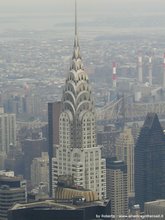Read original...
During the current phase of globalization, New York City’s landscapes are being fundamentally transformed by large-scale and diverse streams of international migration, labor market restructuring and the increasing importance of the informal economy, as well as the distinct ways in which the newest New Yorker’s and their second-generation off-spring engage in politics and community building. These closely linked processes will ultimately mold the city’s economic, social, and political future. While economic, social, and political change brings about winners and losers, the outcomes do not have to be a zero-sum game of winner-take-all.
This brings to the front burner two important questions. Will immigrants and their children experience sustainable economic futures or dismal and precarious socio-economic outcomes? And secondly will our newest New Yorkers organize politically around a progressive, bottom-up, and cross-ethnic and inter-class network of neighborhood and city-wide coalitions or collapse into divisive and implosive ethnic chest-pounding and self-serving political opportunism?
These starkly drawn either/or scenarios are merely points of reference.
Reality is far more complex, messy, and subject to wide and diverse outcomes. Neighborhood quality-of-life, the organization of labor markets, and forms of immigrant civic and political participation are marked by important differences in ethnicity, immigration status, class, race, gender, religion, and social structures. Nonetheless, these differences are ultimately reconfigured within the context of New York’s larger political economy.
During the depths of the 1929 depression and up through the mid-1970s, New York City’s regional political economy revolved around a mixed use small-based manufacturing and service economy, a proactive municipal state, a dense public and private unionized base with political voice(s), city-wide institutions that incorporated the children of late 19
th and early twentieth century immigrants into the civic/political system, and the emergence of vibrant middle and working class ethnic neighborhoods that were characterized by a strong sense of social solidarity. While this arrangement served most New Yorkers well, it largely failed Puerto Ricans and African Americans. This unsustainable inequality in group-based life chances, in part, triggered the ethno-racial and political movements that swept through the city’s neighborhoods during the 1960s and 1970s.
Today, New Yorkers are once again on the cusp of a historical cross-road. Will our Newest New Yorkers be fully incorporated into the city’s economy and political system in a meaningful and sustained manner, or will they be marginalized based on ethnic and racial markers? The outcomes have much to do with the eventual structure of New York City’s regional economy and political factors.
During the past forty years New York’s economic base was fundamentally restructured around a market driven perspective. The New Deal inspired institutional arrangements, which facilitated economic and political incorporation, were largely unraveled by the sing-song of so-called market efficiency, and an accompanying neoliberal downsizing of municipal functions. In effect, New York’s repositioning as a global city resulted not only in the dismantling of institutional structures supporting livable wages and a wide-array of social services for the most vulnerable, but also accelerated dramatic increases in income polarization, fostered increasing levels of informal labor arrangements, and fast-forwarded gentrification and working class residential and commercial displacement. What we are witnessing is the emergence of what has been called the polarized city. In short, a city framed by growing and unsustainable economic, social, and political inequalities.
For progressives and immigrant activists the key question revolves around a fundamental issue: Whose city is this? Are we destined to have a city structured for a privileged sub-set of high-income groups linked to the global economy, or will New York live up to its history as place that welcomes immigrants? While historically New York is a city of immigrants, nonetheless, today’s newcomers encounter a fundamentally different political economic landscape then the one faced by early twentieth century migrants. The last immigrant wave rode the crest of a revitalized mixed economy and a proactive state, while contemporary immigrants are facing a service-based economy that increasingly relies on low-wage informal labor and a market driven state that subsidizes global economic interests and wreaks havoc on middle and working class livelihoods. New situations call for innovative approaches as we go about reworking the political economic geometry that will eventually drive New York’s future. This task requires crafting new structures and methods for organizing bottom-up political practices that meld with the new realities. In doing so concerned folks will have to develop participatory community-based approaches that build upon the many differences and commonalities that frame the everyday lives of our newest New Yorkers.
This changing landscape places progressives and neighborhood activists in the difficult but necessary position of grappling with these reconfigured realities.
The new realities are associated with the global collapsing of time and space that molds immigrants sense of place and community, the crafting of immigrant transnational social and political identities, novel and hybrid forms of political activity, and the emergence of the informal working arrangements as an integral element of the contemporary economy. Yet, in order to grasp and understand these emerging circumstances, individuals of goodwill will have to leave behind the old ways of looking at things. A new language and new ways of thinking are called for. The language and politics of industrialization must give way to new modalities in addressing the challenges associated with an increasingly globalized and market driven environment that churns out few winners and far too many losers.
Are immigrant activists and progressives up to the challenge? In short, will they engage in progressive bottom-up political practices that lead to the construction of a just and sustainable city, or will they drop the proverbial public policy ball? Historical outcomes are not predetermined, they are constructed through visionary political activity and sweat and tears.
During the coming months, I will be writing a series of observations that draw upon my background as a neighborhood activist and as an academic attempting to understand our city of diverse immigrants. In brief, I will open a conversation that brings to the table a range of insights that flow from community activists and academics attempting to navigate and grapple with the changing immigrant demographics and New York’s long-term economic and political future. My aim is to contribute to the working out of a sustainable and socially just future for all New Yorkers. And in launching this conversation, I hope a creative space will emerge where we might begin to think and act collaboratively upon what a just city might mean for all New Yorkers.
Arturo Ignacio Sanchez is a Colombian immigrant, a long-standing member of Community Board 3, Queens, and has a joint faculty appointment with the Cornell University Department of City and Regional Planning and The Latino Studies Program.



































